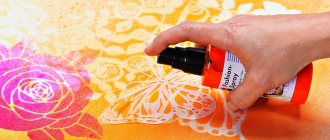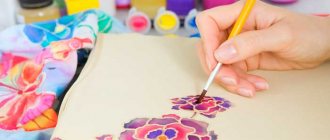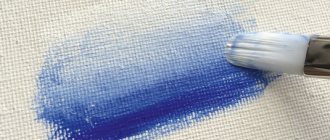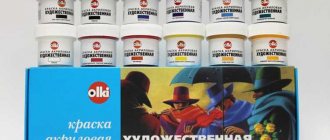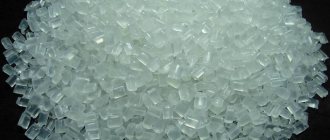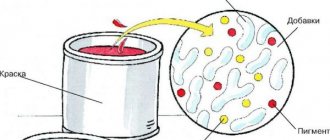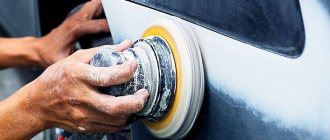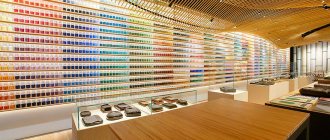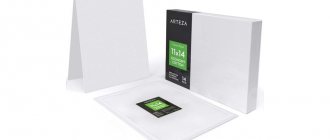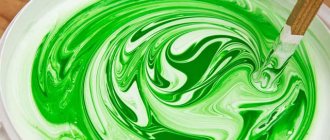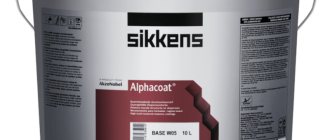Acrylic paints for painting have gained popularity recently. A big role was played by the fact that they are quite simple to use, and the drawings, whether on canvas, wood or stones, turn out very beautiful.
Acrylic is a quick-drying material that forms a waterproof coating. An interesting property of such paints is their versatility in application.
Acrylic painting on stones. Photo
Thanks to their brightness and ease of use, they can be used to create a variety of effects and visual textures on a variety of surfaces, including interior and exterior construction.
Advantages and disadvantages of acrylic paints when painting on different surfaces
Working with acrylic on various surfaces has its pros and cons.
The main advantages and disadvantages are reflected in the table:
| The basis | Advantages | Flaws |
| Canvas |
| If you have untreated canvas, you will need to know how to apply primer correctly. |
| Cardboard, thick watercolor paper |
|
|
| Wood, plywood |
|
|
| Textile |
|
|
| Glass | Fragile material, care required when handling | Has a high cost |
Acrylic paints are a hypoallergenic and environmentally friendly material, do not harm living organisms, and do not emit a strong odor.
Universal paint for painting (acrylic tempera)
Retains all the qualities of traditional tempera: covering, velvety, matte after drying. It is well suited for traditional folk paintings and icon painting, and the acrylic base allows this paint to be used on any surfaces on which acrylic paints are applied. It is perfect for traditional Tagil painting and modern painting using the One Stroke technique.
Materials and tools for painting with acrylic paints
To start using acrylic paints, you should prepare certain materials and tools for the job. This must be done in advance so that while drawing you are not distracted by searching for the desired item. In addition, you need to decide what technique you want to work with, and prepare the necessary accessories accordingly.
Acrylic painting base
Acrylic paints for painting, which even a beginner can use, have certain specific uses on various surfaces, so before starting work you need to decide what base is needed in each specific case.
The bases that are most often used for painting with acrylic are presented in the table:
| The basis | Description | Nuances of use |
| Canvas | The simplest option, perfect for beginners. Made from linen and cotton. It can be sold either ready-made - on a stretcher of various sizes, or simply in rolls, like ordinary fabric. | The material can be sold primed or uncoated. In the second case, before starting work, the canvas should be covered with primer and wait until the layer dries. |
| Cardboard, thick watercolor paper | Suitable for working in watercolor style, when acrylic is diluted with water to obtain the desired effect, does not require priming, and has a rough, dense texture. | The material is cheaper than canvas, but you need to choose thick paper, since thin paper is deformed by water during operation. Textured paper must first be glued to a wooden base, then the air must be expelled with a spatula and allowed to dry. |
| Wood, plywood | Requires priming to work | The primer is applied in several layers and then dried for 24 hours. |
| Glass | Used primarily for stained glass painting | To prepare for work, washing and drying is required. |
Masking tape
Masking tape is used when drawing to clearly delineate layers of paint and obtain perfectly straight lines.
The material is glued by pressing directly onto an already dried layer of paint or onto the canvas so that paint cannot flow under it. The tape must be removed carefully and after the paint has completely dried. You can also use tape to secure the base sheet to the tablet or to create a frame around the edge of the design after removing the material.
Easel or tablet
An easel is a special device for ease of use, on which inflexible bases for painting are placed - plywood, wood or canvas on a stretcher. The tablet is used to attach a paper or cardboard base to it.
Artistic brushes and palette knife for acrylic
To obtain a variety of visual effects in a drawing, you need to have up to 10 art brushes of various shapes and bristle thicknesses in your arsenal.
At the initial stage, you should purchase several of the most common tools:
- flat beveled brushes. The tools are designed for drawing small elements or corners;
- flat shortened brushes. They are used to create thick, dense and clear strokes;
- fan brushes. Tools are used to mix colors and blur boundaries;
- flat brushes. They create bold strokes and paint over large areas of the base;
- round brushes. They are used to apply the main design.
Also, when choosing tools for work, you should take into account the material of the pile. Brushes with a working area made of synthetic, sable or medium hardness are suitable for working in watercolor style; bristles, synthetic or high hardness sable are used when working with thick paints; squirrel brushes are used for painting large areas.
It should be taken into account that when painting with acrylic paints, some pressure is applied to the brush, so the tool must be durable and of sufficient length.
A palette knife is a small, elongated narrow spatula made of steel; you need to have a tool of different sizes in your arsenal.
Using a palette knife, perform the following actions:
- mix pigments;
- remove undried excess paint from the surface of the drawing;
- apply thick strokes of undiluted paint to the base;
- Fill large areas of the design with pigment.
Retarders and mediums for acrylic
Acrylic paints for painting, which can be used either thick or diluted, can be diluted with water or special compounds can be used - mediums and drying retardants. These emulsions make the work much easier, making the paint more pliable, which allows the layer to lay down evenly and maintain color saturation.
With the help of drying retardants, paints can remain in working condition longer, which allows time to correct mistakes in drawing.
Spray
A device with a sprayer is used to spray the surface when painting, which prevents the paint from drying quickly. Fill the spray bottle with cold, clean water.
Palette for mixing colors
In order to get a wide variety of color shades, paints need to be mixed with each other. There is a tool for this purpose called a palette. It is suitable for use with both oil paints and acrylics.
The palette has special recesses into which paints of different colors are laid out. To preserve the original color of the palette, professionals recommend covering it with cling film before use.
Apron and oilcloth
Although acrylic paints are water-soluble, after complete drying they can no longer be washed off the surface and cannot be washed off the fabric, therefore, when starting work, it is best to wear special clothes or have an apron with you.
The working surface is covered with a protective oilcloth.
Water in a jar
In order to put a dye of a different color onto the brush, it must be thoroughly washed of the previous pigment. Typically, 2 jars of clean water at room temperature are used for these purposes. One is used for the initial washing of paint from the brush, and the second for subsequent rinsing of the tool.
Using acrylic paints in home renovations. Their features.
What is acrylic paint used for when renovating a home? The most common option for their use is in painting walls for children's areas. The properties of the paint allow you to maintain environmental friendliness, beauty and comfort. Environmentally safe is the most important reason to use these particular paints; not a single element is used for production that can destroy the environmentally friendly layer or harm human health. No less important is the fact that acrylic is fireproof and contains no flammable components. This fall is important for painting children's areas and areas located near fire or heating elements.
Using acrylic paint is beneficial for saving time in repairs, as it dries very quickly. It will take 1-3 hours for the paint layer to harden.
If the design project is intended to create an extraordinary interior, such paints will provide a huge selection of palettes. This will allow you to make a corsac in a unique range. If children go to see a rainbow in their room, then with acrylic paints this will be done very easily and quickly. An important difference between acrylic and other paints is the ease of washing off paint from hands and objects to be painted.
The properties of the paint include the fact that its film layer does not block the penetration of air through the surface of the paint. If the walls or partitions are made of wood for environmentally friendly purposes, then by covering the walls with such paint the air will not stagnate in the room, but the paint layer will remain moisture resistant.
Acrylic paint is resistant to UV radiation, moisture and mechanical damage, this makes it possible to carry out repairs using acrylic not only in children's areas, but also for finishing facades, also in any microclimate.
This type of paint can be applied to almost any type of surface, with the exception of some types of plastic.
In construction and repair work, paints on two bases are most often used, these are:
- Organic solvents. The advantages of this base are that they are more suitable for finishing work on facades. You can work with such paints from -20 to +30 degrees. This makes it possible to paint elements in almost any weather. A durable, elastic layer is created on the surface of such paints, allowing air to pass through it, but at the same time acrylic retains moisture. An integral advantage is the use of this paint in the treatment of wooden coatings, as it protects the wood from fungi and mold.
- On a water-dispersion basis. This composition is more suitable for carrying out repair and finishing work indoors. This is an environmentally friendly option for treating walls and surfaces. The water base is environmentally friendly. If you need to paint the ceiling, it is better to use matte acrylic paints. For rooms with high humidity, it is recommended to use paints with a glossy effect.
Why and how to dilute acrylic paints?
Acrylic paints for painting, which can be used either in their original form or diluted, belong to the water-dispersed group. They basically contain water, not organic solvents, so the material is well diluted with water and diluted with pigment compositions on the same basis.
Acrylic paints for artistic drawing initially have a thick consistency, so before starting work they need to be diluted with water or a special emulsion.
Most often, dilution is used in the following situations:
- the paint is applied to the base by spraying from a spray gun, in this case it lies evenly on the base;
- if painting work is carried out in a ventilated and warm room, in this case it is necessary to slow down the drying time of the paint layer;
- if the remaining dye begins to harden during operation.
To dilute paints, emulsions are used, which can be purchased at specialized points of sale. They must be mixed in strict accordance with the manufacturer's instructions.
In order to get a good dye after mixing paint with water, you should follow these recommendations:
- The liquid must be used distilled; it can be purchased at car dealerships or pharmacies;
- if you have to add water from a regular tap, in this case it must be left for 24 hours so that the chlorine evaporates and the impurities settle to the bottom;
- It is necessary to dilute the paint with liquid until a homogeneous mass is obtained in a separate clean container.
Water must be added in the exact ratio:
- to paint the bottom coating, water is mixed with paint in a 1:1 ratio;
- to obtain a smooth secondary layer, a 1:2 ratio of paint and water is used;
- A translucent layer during glazing can be obtained by mixing water and paint in a ratio of 5:1.
Since water changes the properties of paint, if there is excess liquid, acrylic will not stick to the base, so it is important to follow the dilution recommendations.
Basic techniques when working with acrylic
- Wet. The diluted paint is applied to a canvas moistened with water. It is somewhat reminiscent of working with watercolors.
- Dry. You will need several brushes to edit the strokes on the canvas “dry”.
- Glaze. This technique involves the formation of a pattern from thin translucent layers. By adding layers step by step, we get beautiful iridescent colors that give our painting a richness and sophisticated mood.
- Impasto. Very similar to working with oil paints using the impasto technique. Dense, opaque paste layers applied with a flat brush or palette knife (something like a small spatula) can create relief. Impasto is a special painting technique, completely opposite to the glazing technique!
Let's consider this the first among acrylic painting lessons.
How to prepare the base?
If an already primed canvas was purchased for work, then the preparation will be to fix it on a stretcher. The material is ready for use, as it does not need to be sanded or cleaned of contaminants. Also, special paper or cardboard does not require pre-treatment; the base only needs to be secured to the tablet with masking tape.
All other surfaces require priming and subsequent final treatment. To prepare a canvas or wood base, you need to purchase a special primer for acrylic paint. Its composition contains barite with magnesium and calcium carbonate - these components help to form the correct surface texture.
The primer can be applied horizontally or vertically. To apply a very liquid composition, use only 1 method; in other cases, any of the methods will do.
Application of primer to the base must be carried out in the following sequence:
- First you need to carefully lay out the base.
- Then you need to pour the primer onto the surface.
- Then you need to quickly distribute the composition over the canvas using a rubber spatula or squeegee.
- Smoothing movements must be continued until a uniform thin layer is obtained.
- After this, the base should be left to dry.
After applying and drying the primer, the canvas must be secured to the stretcher with staples using a construction stapler.
Preparing the base
The basis can be anything that requires your attention in artistic transformation: a piece of cardboard, a plywood board, a canvas on a board or an easel stretched on a stretcher.
Is it possible to make your own canvas to paint on? Yes. And even necessary! The law is simple: when we learn to draw, we learn to make a canvas for drawing on our own. For example, a wooden board will serve as the basis for our future masterpiece. How to make sure that the polymer of acrylic paints can easily “catch” and not crumble later? For the best adhesion effect (adhesion), we take texture paper or origami paper and glue it with decoupage glue over the area of the board on which we will paint with acrylic.
So that the background for the drawing is smooth, and the drawings themselves turn out bright and beautiful, without distortion (the kind we need!), use a needle to remove all the bubbles that appear on the future canvas - we make a puncture in each and remove the air. But even now something is missing to start drawing correctly. Our canvas looks clearly unpresentable. Painting on a fresh canvas is postponed: you need to use canvas primer.
We will use 10-15 layers of decoupage glue as a primer, each of which is applied only after the previous one has completely dried.
The time has come to polish our base, for which we have prepared sandpaper. They do this: lightly moisten the surface of the canvas with water and rub it to the desired gloss. The smoother the first layer of soil, the easier it is to paint on the canvas. Now we need to get a uniformly white background. To do this, we have used whitewash all our lives, we will do the same. Apply, wait for it to dry, and if necessary sand again.
The “canvas” we make contains all the characteristics for creating a painting with your own hands, on which artistic acrylic paints will easily and firmly lie.
How to use acrylic paints, features
Acrylic paints for artistic drawing have characteristic differences from student paints - they are available in a wide variety of shades and have a more saturated tone. They are easy to use; at the initial stage it is recommended to have a set of 7-10 colors.
Artists recommend having the following basic shades with you:
- white;
- green:
- brown:
- pink or purple;
- black.
To learn how to create unique paintings, masters advise following these recommendations:
- Using a palette knife or brush, you can mix paints on the palette to create new color combinations and rich shades. When performing this procedure, using a color disk will help; it will make it easy to understand what color you will get when mixing certain paints;
- adding water will help lighten the paint and give it a watercolor look;
- to change the texture, acrylic paints can be mixed with texture pastes, this will allow you to create and highlight different areas in the picture;
- mixing paints with varnish will create a shiny and silky effect;
- If you put 2-3 layers of paint on top of each other, you can get an interesting layering effect. Here you need to take into account that each layer must be given at least 30 minutes to dry;
- to create a bubbling effect, you need to make blotting or smearing movements with a regular sponge, dipping its corner into the paint;
- The splashes will give the painting an original look; they can be obtained by clicking your finger on the end of the brush, moistened with paint;
- an abstract drawing is obtained by applying lines in small strokes or dots with the end of the brush, holding it vertically to the base.
A wonderful effect can be achieved by mixing paints not on the palette, but directly on the base in those places where you need to paint a large space, for example, when drawing fields or an autumn forest.
When mixing with water, you should take into account the fact that the shade of the paint darkens after drying, that is, you need to dilute the pigment a tone lighter than necessary. You can also lighten dark paint by adding a white tone.
When painting on canvas, fabric
Special paints that are labeled with the word “batik” are suitable for painting on fabric. They are available in a wide range of shades and are durable, flexible and moisture resistant. Dyed fabric can be washed at a temperature not exceeding 60 °C.
The dye is applied directly to the fabric, and a fixative is used to separate the color boundaries. This product is called reserve and can be made from gasoline, water or paraffin.
When drawing on a smooth surface, painted walls
Acrylic paints are convenient to use for painting on walls because they have the following features:
- dry quickly;
- they are environmentally friendly and do not have a harmful effect on the human body;
- wide palette and ease of mixing, which allows you to create any pattern.
When painting walls, it is better to choose durable paints that form a water-repellent coating - this will allow wet cleaning without harming the painting. Before decorating a smooth surface, special attention should be paid to degreasing it.
If this is not done, the paint will not stick. Plastic must be treated with an antistatic agent, since during the painting process dust and lint can be attracted to it, which will ruin the design.
Acrylic paints for wall painting are made on the basis of artificial resins, and the pigment can be either synthetic or natural. Using artificially created pigment, the color of the paints is bright, dense and rich. If a pigment of natural origin is used, the color of the paint is delicate, soft and has pastel shades.
When drawing on rough, uneven surfaces
Decorating uneven and rough surfaces has the following features:
- Before painting, the area to be treated should be degreased and cleaned with fine-grained sandpaper;
- Before applying the design, the surface should be covered with a primer material, otherwise the image will be uneven;
- if the wood has been pre-painted. Then there is no need to apply a primer layer;
- An adhesive layer must be applied to the plywood, which will strengthen the adhesion of the paint and the material.
The best acrylic paints for walls and ceilings
When performing repair work on walls and ceilings, the most environmentally friendly water-based compounds are used. Among the main technical parameters, attention should be paid to hiding power and decorativeness. Experts liked several acrylic paints.
Tikkurila Magnetic
Rating: 4.9
Acrylic paint is available in containers from 0.5 liters and is white. The required shades are obtained by tinting. The product is intended for painting indoor walls and dries in 24 hours. If you need to make the consistency thinner, dilution with water is allowed. Users in reviews note the economical consumption of 15 m² per liter. The substance adheres well to wood, drywall, and concrete. You can paint the walls with a roller or brush, but nothing will work with a spray bottle.
The trick of acrylic coating is the presence of metal particles in the composition. After drying, the walls will be magnetic. This is convenient for attaching a calendar, photo, poster, or exchanging notes within the family. At the same time, the walls do not deteriorate, and the large area allows you to attach objects of unlimited size (unlike the surface of the refrigerator, which can accommodate 20 magnets). Although paint can be used on any wall in a room, experts recommend acrylic coating for a child's room. This will make it more fun for your child, and the surface will not be covered with numerous punctures from pins and nails.
Advantages
- can be tinted in any color;
- good adhesion to concrete, drywall, wood;
- diluted with water;
- magnets subsequently stick to the surface.
Flaws
- high price;
- not suitable for spray bottles due to metal particles in the composition;
- dries in 24 hours.
Procedure for working with acrylic paints, painting techniques
Acrylic paints for drawing, which are easy to use, allow you to well convey the mood and intention of the artist due to their brightness and richness.
Creating a drawing consists of several successive stages:
- First, with the widest flat brush you can apply a general background to the base.
- Then, using flat brushes with large numbers, you need to draw the outlines of those large images or objects that you plan to depict. This can be done using matte opaque shades. For example, when drawing a mountain landscape, you should first draw the outlines of the mountain peaks.
- Once the general outlines of the drawing have been drawn, you can begin to detail the images using smaller brushes.
- After the work is completed, it can be varnished.
To prevent the paints from drying quickly, the image should be sprayed with water using a spray bottle at intervals of 11-13 minutes. so that the work is moist but not wet.
When changing colors, be sure to rinse the brushes in several jars of water, after which you should blot the handle and bristles with a paper napkin to remove excess moisture. If this is not done, drips may form during further drawing.
If unnecessary paint residues have formed, it is not recommended to wash them down the drain. It is best to wait until they are completely dry and then throw them in the trash.
Glaze
When working in this technique, the pattern is formed by layers superimposed on each other. In this case, the paints must be diluted to a translucent state and the previous layer must be completely dried. The more layers are applied, the more voluminous, deeper and more expressive the image will be.
In this technique, colors are not mixed with each other, and additional shades are obtained by applying layers. To obtain the desired tone, a color table is used. For example, to get a green tint, you must first apply a yellow pigment diluted with water, and after it dries, apply a diluted blue color on top.
"Dry" technique
This technique involves painting without first wetting the brush with water, for which paint is picked up with a dry tool and immediately applied to the base. Therefore, there should be several brushes and after rinsing they should be blotted dry. The technique makes it possible to clearly identify color transitions and naturally depict the unevenness of objects.
Imitation watercolor
This technique involves applying paint diluted to a liquid state onto the canvas, which is also pre-moistened with a spray bottle. The more acrylic paints are diluted, the more delicate and transparent the shade will be.
Impasto technique
This technique is reminiscent of impasto oil painting. Layers need to be applied with a palette knife or a flat brush, resulting in thick and relief strokes, which creates a voluminous texture and visual illusion.
It is better to use acrylic paints in tubes for the impasto technique.
Acrylic paints for painting “Acrylic-Art”
They are as close as possible to oil paints in consistency, so that they can be used with both a palette knife and a hard brush, giving the work relief and texture of strokes. Glossy when dry and translucent for glazes and tone transitions.
Now, when you see a painting painted with acrylic, you are unlikely to distinguish it from a painting painted in oil. Old school artists say that acrylic is not a time-tested paint. The oldest work in acrylic is less than 60 years old, while oil work as an art medium dates back centuries. However, modern paints are gaining more and more popularity, and for good reason. Acrylic dries quickly, acrylic paints can be used on almost all surfaces and have increased resistance to external influences.
When using acrylic, you should remember that after drying it darkens by half a tone.
The best manufacturers of acrylic paints, cost, colors
There are several manufacturers on the market for artistic acrylic paints.
Acrylic paints for painting Maimeri
The best of them are the following brands:
- Koh-i-Noor. The paints of this Czech company are distinguished by their pure color and brightness; the palette consists of 10-32 colors. The cost of the set is from 1,200 rubles;
- Lefranc & Bourgeois. Paints of this brand can be applied to any surface, including plasticine and clay, the material has good adhesion. Paints are sold in bottles of 75-120 ml or tubes of 10-20 ml. The cost of a set of paints in a tube is 1-5,500 rubles. depending on the number of flowers. A bottle of plain paint can be purchased for about 500 rubles;
- Maimeri. This is an Italian brand, dating back to 1923, the palette is represented by several series, the largest - Maimeri Acrilico - contains 79 stable and durable colors, there are also shades designed to create shine and shimmer. The cost of a bottle of paint with a volume of 75 ml is 300-400 rubles;
- Ferrario. The brand has been operating since 1919, produces several series of 50 colors, the paints are durable, dry quickly, and do not crack. Bottle volume – 40 ml. Cost – 300 rubles;
- "Gamma". A Russian company operating since 1899. The brand’s paints have high light fastness, heat and water resistance, do not fade, and adhere tightly to the base. Paints are sold individually in a 46 ml tube, their cost is 100 rubles, or in a set of 5 colors (each container contains 75 ml of paint), the cost of which is approximately 1,100 rubles;
- "Nevskaya Palitra" This is a Russian factory of artistic paints that has been producing high-quality products since 1934. The range is represented by sets of paints from 8 colors, tubes have a volume of 18, 46 or 75 ml. Cost – from 500 rub.
Acrylic paints for painting are suitable for both experienced and beginning artists. They are easy to use; the presence of various application techniques allows you to create real artistic masterpieces. The paint market is represented by a large selection of manufacturers in different price ranges.
Which acrylic paints are best for painting: TOP brands
Nylon and synthetic brushes are suitable for acrylic
I think that after such a detailed article you will no longer have any questions about acrylic and you will be able to go to the store with peace of mind and buy everything you need to start creating your masterpieces very soon!
And here, in fact, are my TOP 6 artistic acrylic paints for painting:
- Expensive foreign paint “Winsor&Newton”
- French paint "PEBEO"
- Domestic paint and the familiar Master Class brand
- The same – artistic acrylic paints “Sonnet”
- “Acrylic-Art”, from the St. Petersburg brand “Tair”
- “Vista-Artista” paints, also known as “Gamma”
- And, of course, the most popular option is BRAUBERG ART “CLASSIC”. I often use this paint myself.
All these colors are good in their own way. When choosing any of them, you definitely can’t go wrong with either quality or price. Of course, some of them will be more expensive, some will be cheaper, but no matter what you choose, you will be able to paint a picture with any of them.
If you want a paint that is not expensive compared to foreign acrylic paints, but of good quality compared to Russian analogues, take either BRAUBERG.
These are the best acrylic paints for students and professionals. And yes, you can order them in my store - https://nyshop.pro/shop-2/
What to do to prevent acrylic paints from drying out
If drawing is just a hobby, and the artist rarely uses brushes, then you need to take care of the safety of the paints in advance. To maintain the material in working condition, it is necessary to regularly mix it with a wooden spatula until it has a uniform consistency, and add water when it thickens. The best option is to store paints in tightly closed jars or place the palette in zip bags. Air from the bag itself must be removed as much as possible.
The best option is to store paints in tightly closed jars or place the palette in zip bags.
What to do if acrylic paints have already dried
If the material has already dried, then you can return it to its previous state using boiling water. To do this, the dried piece is thoroughly crushed in a jar and gradually poured with boiling water. Stirring the material regularly, add boiling water in small portions until all lumps are completely dissolved and the required consistency is achieved.
If the material has already dried, then you can return it to its previous state using boiling water.
How long does acrylic paint take to dry?
The material dries quickly and cannot be wiped off later. When painting, it is important to consider how long liquid acrylic paints dry, depending on the manufacturer’s recommendations, and to tightly close each jar. If acrylic is in tubes, then squeeze out a small amount, and when purchasing a palette, you must additionally acquire a spray bottle. When painting, it is necessary to regularly spray the material so that water particles remain in the air, which will slow down the drying process. You can dilute the paints with plain water, but for those who decide to take painting seriously, it is recommended to acquire additional tools:
- Medium - increases the elasticity of paint without compromising brightness;
- Thickener - suitable for liquid materials;
- The thinner will increase fluidity without disturbing pigmentation (as happens when diluted with water);
- A retarder is necessary if there are small details in the drawing, and the master’s hand has not yet been developed. This tool will allow you to slow down the process in order to make timely adjustments to the drawing.
The material dries quickly and cannot be wiped off later.
